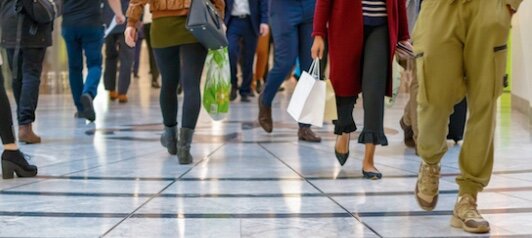Tips for Freezing of Gait in Parkinson’s Disease
DR. BERNAL-PACHECO
Walking should be fun and safe. In persons with Parkinson’s disease, there are many reasons that gait can be impaired including decreased stride length, balance difficulties, decreased blood pressure when standing up and freezing of gait (FOG). Gait can be tricky to treat as often there are multiple issues contributing the dysfunction.
There is a great resource for FOG and its levodopa paradox published recently in JAMA Neurology by Jorik Nonnekes, Matthieu Berauu and Bas Bloem.
FOG is a bothersome symptom. It is common and some experts quote that FOG occurs in 80% after 20 years of Parkinson’s disease. FOG can be a cause of significant safety issues as falls can lead to hospitalizations and surgeries. FOG can lead to hip fractures or bleeding into the area around the brain (e.g. a subdural hematoma). FOG can impact independence and quality of life. We sat down with Dr. Bernal-Pacheco to get some of his tips for FOG.
Who is Oscar Bernal-Pacheco MD?
Oscar Bernal-Pacheco obtain his medical degree from the Universidad Nacional de Colombia, Neurologist of the Universidad Militar (Colombia) and completed a movement disorders fellowship of the University of Florida, Gainesville (USA). Currently he is professor of the Universidad Militar, Hospital Militar from Bogotá (Colombia) and Co-director of the movement disorders clinic in the Hospital Fundación Santafe de Bogotá and Instituto Ortopedico Roosevelt.
By Jonny Acheson
1. What is freezing of gait?
Freezing of gait (FOG) is a disabling symptom, which is more common with advancing Parkinson’s disease (PD). Patients may describe FOG as feeling as if their “feet are glued to the ground.” FOG can cause a “transient absence or even a marked reduction of forward propulsion of the feet despite the best intention to walk.” FOG has been described as an “episodic inability to create effective stepping.” In some patients FOG can cause them to become completely frozen. In another form of FOG there is shaking in the knees coincident with an inability to step forward.
2. When can FOG episodes occur?
FOG in PD has been reported during many activities:
· When turning (perhaps the most common cause of FOG)
· When initiating a movement i.e. when starting to walk
· During the act of walking
· When entering or crossing through a narrow space or doorway
· When approaching an obstacle (i.e. a person)
· In open spaces (the least common manifestation)
3. What can I do to avoid FOG?
There is unfortunately no 100% reliable method to prevent FOG, but these tips may help.
· Exercise
· Practice the activities that precipitate FOG and work on solutions with a physical therapist or personal trainer.
· Physical and occupational therapy .
· Optimizing medications for the motor symptoms and fluctuations (i.e. move doses closer together to avoid wearing off and related freezing).
· Optimizing medications for non-motor symptoms (sometimes anxiety can contribute to FOG)
There is an awesome article in JAMA Neurology by Bas Bloem and colleagues with a set of videos on compensation strategies for gait impairments in Parkinson’s.
4. I´m taking meds for PD, but I don´t feel like it helps my FOG.
FOG occurs more frequently in the “off medication” state, but it can also occur when medications are otherwise working well (i.e. the patient is in the “on state”). If FOG occurs when the patient is in the OFF state, then adjusting PD medications may improve the FOG. However, if the FOG occurs in the ON state may not in some cases be dopaminergic medication responsive (and in some cases may not be PD).
Medications may rarely cause FOG. One clue is that if you wake up in the morning off your medications and you walk well until you take your medications you may benefit from lowering the dopaminergic dose.
Finally, non-PD medications and other comorbidities such as spinal stenosis, hip and knee arthritis, strokes and neuropathy can all contribute to FOG.
5. What kind of therapies help FOG?
Physical therapy can be helpful. Occupational therapy may also be helpful and can assist persons with PD in returning to pleasurable activities. Practicing walking with assistance can be helpful. A home safety evaluation where a therapist comes to the home can set you up for future success (e.g. rugs and furniture and bathroom changes).
By Jonny Acheson
6. Is physical therapy effective for FOG?
An assessment by physical therapy is definitely beneficial to anyone living with PD. The benefits of PT may not be universal to all comers. Dementia or cognitive loss can for example render learning from a therapist challanging. It is important that patients view therapy as an instructive lesson and not just a passive activity. The goal of therapy is to learn exercises that can be practiced in between sessions and can be sustained after the therapy sessions have concluded.
Depression and apathy can affect the ability to perform exercises.
Pain, orthopedic issues, poor muscle strength, and limitations in heart or lung function can limit the ability to participate in therapy. Patients who perform best often report a positive attitude and belief that they are self empowering. A motivated caregiver or a friend can be helpful in reinforcing PT related learning. Every patient requires an individualized evaluation and a tailored therapy intervention in order to obtain the right diagnosis and the right therapy.
Examples of therapy include: motor learning, action observation, computerized training, exercise, slackline training, curved-waking training, aquatic therapy and robot-assisted gait training.
7. In patients with deep brain stimulation (DBS), does FOG improve?
Process for DBS Screening
FOG can possibly respond to DBS in the same way that it can respond to levodopa. About 1/3 of patients with “off medication” FOG improve following DBS. It is difficult to predict who will and will not improve post-DBS. There may be a few programming settings that may help. FOG is most commonly a symptom that does not or partially responds to medications or to adjustment of the DBS.
8. My neurologist says that I´m not a good candidate for DBS because I have FOG?
Postural instability (i.e. imbalance) when accompanied by FOG can result in falls and related trauma. Performing a levodopa challenge test (to see a patient on and off levodopa treatment) can help to predict if the person will have a benefit with DBS treatment. FOG not responding to levodopa will usually not respond to DBS and sometimes worsen.
9. Is there a non-surgical device for FOG?
There are some assistive devices that usually work by giving cues. A metronome sound, which is a rhythmic auditory cue, can sometimes help FOG. There may be visual cues as well such as stepping over a laser light or a straw attached to a cane (i.e. an inverted cane). There are walkers such as the U-step which can help freezing by using cues. Patients who have issues with poor vision, hearing or cognitive difficulties may not respond to the cues. Ultimately safety and fall prevention is the most important goal. Many persons with PD should use a walker and avoid high risk which may lead to a fall. Climbing ladders, being on a roof or slope and hard concrete surfaces should be avoided if possible. Areas of visual clutter such as farmer’s markets, busy shopping centers, the airport and the theater can in some cases worsen FOG.
This blog is brought to you by Michael S. Okun and Indu Subramanian.
To read more books and articles by Michael S. Okun MD check Twitter @MichaelOkun and these websites with blogs and information on his books and http://parkinsonsecrets.com/ #EndingPD #ParkinsonPACT #Parkinsonsecrets and https://www.tourettetreatment.com/
He also serves as the Medical Director for the Parkinson’s Foundation.
To see more on Dr. Indu Subramanian she does live interviews of experts in Parkinson’s for the PMD Alliance














